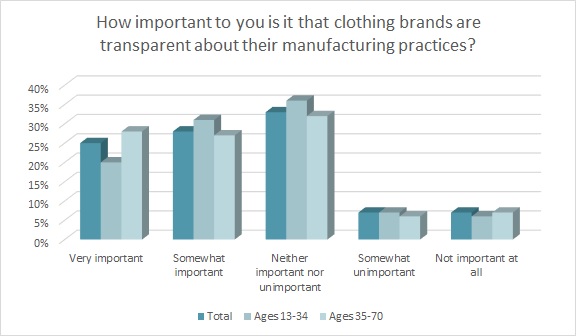Now that consumers are becoming more conscientious shoppers, it seems everyone from artisan-produced luxury labels to discount mass retailers are positioning themselves to appeal to those seeking more sustainable product.
When Studio 189 showed its Spring/Summer 2020 collection at the recent New York Fashion Week, the brand’s co-founders, actress Rosario Dawson and Abrima Erwiah, put sustainability at the forefront, both in the generous use of cotton (some recycled) and denim (some upcycled), and in their show notes, which reminded the crowd of the label’s prestigious CFDA Lexus Fashion Initiative award for sustainability.[quote]
And earlier this year, Old Navy launched its Heart Earth sustainability initiative, whose two big goals by 2022 are having 100 percent of its denim made with water-saving techniques, as well as sustainably sourcing 100 percent of its cotton. As the company pointed out, Old Navy sells 27,000 Rockstar jeans every day, “making the scale of our sustainability goals around denim and cotton significant.” The company said the initiative was meant to communicate product sustainability efforts directly to its customers. Such efforts clearly aren’t hurting the bottom line: Old Navy recently announced plans to open 800 new stores, doubling its doors to 2,000.
“I think new consumer demands for sustainability and transparency are definitely forcing brands and retailers to position themselves differently,” says PSFK’s Penn Whaling, chief strategist for the business consultancy. “As consumers become more aware of the true environmental costs of their garments and are attempting to be more deliberate with their purchases, there’s been a clear shift in the last few years. It’s been interesting to see fast fashion brands in particular emerge as leaders in sustainability. As they work to shed their ‘disposable’ image, we’re seeing companies like H&M attempting to introduce sustainability in all aspects of their products’ life cycles, from using fabrics made from biodegradable materials to extending the lifespan of their garments by experimenting with resale platforms.”
Consumers overwhelmingly want fashion brands to address environmental issues. Overall, 86 percent of consumers say companies should address urgent social and environmental issues, according to the Cone Generation Z CRS study. That figure significantly increases to 94 percent among Gen Z shoppers.
Additionally, most consumers (53 percent) say it’s “very/somewhat important” that apparel brands are transparent about their manufacturing practices, according to the Cotton Incorporated Lifestyle Monitor™ Survey. This rates higher among Gen X shoppers (59 percent), many of whom are in their parenting years. Further, 51 percent of consumers overall, and 58 percent of Gen X say they are “very/somewhat likely” to shop at a clothing brand that honestly communicates about its environmental and societal impacts compared to one that does not.

Kayla Marci, market analyst for Edited, the retail tech company headquartered in London, confirms that as sustainability and eco initiatives have made daily headlines, there’s been a shift in the way retailers are positioning themselves in their messaging with customers.
“Communications around sustainability have seen a gradual increase as the year has progressed,” Marci says. “Retailers are demonstrating their awareness of the toll fashion takes on the environment by highlighting a wide range of topics in marketing from eco-friendly product edits to outlining sustainability goals. Drawing attention to environmentally friendly fabrics has been a key topic, promoted by several retailers. Mentions of sustainability, eco, recycled, conscious and iterations were at an all-time high in April when both Earth day and Fashion Revolution Week took place.”
When asked about the meaning of sustainability when shopping for clothes, most consumers (45 percent) said it meant “long lasting,” according to Monitor™ research. That was followed by “environmentally friendly” (17 percent) and renewable (12 percent).
Since 2011, consumers have been raising their apparel standards, moving away from the cheaply made fast fashion that permeated their wardrobes. Monitor™ research shows 61 percent of men (up from 49 percent) and 56 percent of women (up from 50 percent) say quality is important for clothing purchase decisions. Overall, 62 percent of consumers say cotton clothes are higher quality, last longer, and ultimately costing them less.
Brands should also note that 81 percent of consumers say cotton is their favorite fabric to wear, according to Monitor™ research, and 82 percent say it’s the most sustainable. Further, consumers expect the industry to help them out when it comes to making eco-conscious choices, with the majority of consumers (58 percent) saying they would blame the industry (manufacturer, brand, and store) for clothes that are produced in a non-sustainable manner.
Perhaps then it makes sense that both Studio 189 and Old Navy would readily use so much cotton in their men’s, women’s, teens’, and children’s collections.
“Today’s consumers, especially younger consumers like Gen Z, are seeking personal, emotional connections to their favorite brands and therefore want to support brands that share their same values,” says PSFK’s Whaling. “This means that they are hyper-aware of things like ‘green washing’ and quick to call out any sustainability or social impact initiatives that seem self-serving or inauthentic, as they seem like a betrayal of these shared values. In order to address consumer concerns, brands should engage in a two-way conversation with their consumers and determine which issues are most important to them, then figure out ways that make sense for them to address these concerns from an organizational point of view.”
Edited’s Marci says that as consumer demand for sustainable fashion grows, online brands are making it easier to shop these products in their site navigation.
“Eco edits and collections are highlighted on retailers’ websites — mostly placed under ‘Edits’ or ‘Campaigns,’” she says. “A small number of retailers, including ASOS, now allow consumers to search for products using sustainable and animal-friendly filters.”
Such information isn’t just helpful to consumers; it’s beneficial to retailers. Monitor™ research shows that nearly one-third of consumers (30 percent) who shop or browse clothing online say knowing environmental footprint information would influence their ultimate decision to purchase clothes online. And more than 1 in 3 (36 percent) say they’re “very or somewhat likely” to pay full price for apparel that is made in a sustainable or environmentally friendly way.
Whaling says companies can additionally help consumers who want to “do right” by taking the onus off them to responsibly dispose of clothing at the end of their lifecycle. He suggests brands and retailers implement resale platforms, refurbishment and repair services, and recycling programs that make the process seamless for shoppers. Companies like Yerdle and Patagonia, he says, are making it easy.
Edited’s Marci says that with an increasing number of retailers promoting sustainable messaging, “the ones that will stand out are those that are authentic and transparent with customers.”
